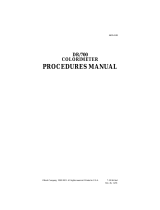Page is loading ...

COLOR COMPARISON TEST
ORTHOPHOSPHATE (5-100 ppm)
COMPONENTS:
1 x 2269 Cap, Dispenser, 18 mm, natural (or #2280, 28 mm, white)
5 x 4023 Test Tube, Calibrated (5 mL), glass
1 x 4027 Funnel, 58 mm, plastic
1 x 5160 Instruction
1 x 6003 Brush, Test Tube
1 x 6009 Filter Paper, 9.0 cm, #610, 100/box
2 x 9021 Test Tube, Mixing, Calibrated (5, 10, 14, 15, 17.5 mL), glass w/ stopper
1 x 9110 Slide Comparator, Orthophosphate, Stannous Chloride, 5-100 ppm
1 x 9190 Base, Slide Comparator (for test tubes)
1 x R-0601-C Molybdate Reagent*, 2 oz (or R-0601-E, 16 oz)
1 x R-0602P-I Stannous Chloride Powder, 10 g
TO ORDER REPLACEMENT PARTS AND REAGENTS CALL TOLL-FREE
800-TEST KIT (800-837-8548).
PROCEDURE:
CAREFULLY READ AND FOLLOW PRECAUTIONS ON REAGENT LABELS.
KEEP REAGENTS AWAY FROM CHILDREN.
Orthophosphate Test
1. Filter water to be tested to clarify.
2.Rinseandllonemixingtesttube(#9021)to5mLmarkwithlteredsample.
3.Diluteto15mLmarkwithdistilledordeionizedwater.Stopperandmix.Removestopper.
Transfertotwo5mLtesttubes(#4023)to5mLmark.
4.Wipedryandplaceintwoholesadjacenttocenterholeofcomparatorbase(#9190).
5.Rinseandllsecondmixingtesttube(#9021)to5mLmarkwithlteredsample.
6.Cap R-0601 Molybdate Reagent with dispenser cap (#2269 or #2280). Add R-0601
MolybdateReagentto15mLmark.Stopperandmix.Removestopper.
31LovetonCircle,Sparks,MD21152U.S.A.
800-TESTKIT(837-8548) • 410-472-4340 11/16
7.Add2leveldippersR-0602PStannousChloridePowder.Stopperandmix.
8.Wipedryandplaceincenterholeofcomparatorbase(#9190).WAIT1MINUTE.Readbefore
5minutes.
9.PlaceSlideoncomparatorbase.Matchcolorincentertesttubewithacolorstandard.The
SlideisinproperalignmentforacolormatchwhenawhitelineontheSlideisdirectlyabove
thewhitelineonthecomparatorbase.Recordaspartspermillion(ppm)orthophosphate.
NOTE: Ifsamplecolormatchesorisdeeperthanhighestcolorstandard:Dilutesamplewith
distilled,deionized,orphosphate-freewater.Repeattest.Forsampledilutedwith1
partwater,multiplyreadingby2;for2parts,multiplyby3,etc.
*WARNING: MolybdateReagent(R-0601)contains5–10%(w/w)sulfuricacid,acorrosive
acid.
Instr. #5160

SLIDE & MIDGET COMPARATOR TESTS
ORTHOPHOSPHATES & POLYPHOSPHATES IN GENERAL
This method is based on the formation of phosphomolybdic acid, which is subsequently
reduced with stannous chloride to produce a blue color whose intensity is proportional to
the phosphate (PO
4
) present. Interferences are reduced to a minimum. The presence of
10,000 ppm of silica (SiO
2
), 100 ppm of ferrous or ferric iron, or 1000 ppm of sulte causes
no error.
The water to be tested must be carefully ltered with a good grade of lter paper to free it
from sludge and scale. Mere traces of sludge will cause serious errors.
If repeated ltration does not clarify the water, add 0.5 g potassium nitrate crystals to 25 mL
of the sample water, heat to boiling, cool, dilute to 25 mL with distilled water, and lter.
If the water is very highly colored by tannin or other highly colored organic matter, so that a
phosphate determination is dicult or impossible, it can be eectively decolorized with
activated charcoal. Add half a teaspoon of activated charcoal to a pint container of the
colored sample water. Close the container and shake sample well. Decolorization should
take place in 5 to 15 minutes. The treated sample is then ltered as instructed above. From
this point on follow the procedure outlined in the Orthophosphate or Polyphosphate tests.
31 Loveton Circle, Sparks, MD 21152 U.S.A.
800-TEST KIT (837-8548) • 410-472-4340 8/16
Instr. #5159
/


